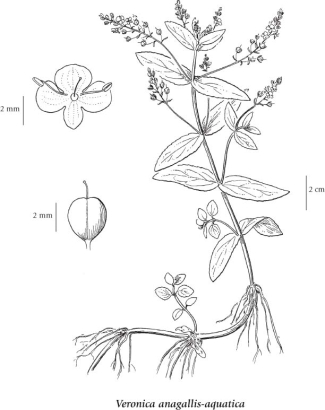Veronica anagallis-aquatica L.
blue water speedwell (water speedwell)
Plantaginaceae (Mare's-tail family)
(Previously in Scrophulariaceae)
Introduction to Vascular Plants
blue water speedwell (water speedwell)
Plantaginaceae (Mare's-tail family)
(Previously in Scrophulariaceae)
Introduction to Vascular Plants
Map
Distribution of Veronica anagallis-aquatica
Click here to view the full interactive map and legend
Species Information
General:
Perennial or sometimes biennial, amphibious herb from a shallow creeping rhizome, smooth throughout or thinly glandular-hairy in the inflorescence; stems decumbent to erect, 10-70 cm long/tall, rooting at the lower nodes, simple to much-branched at the base, somewhat fleshy.
Leaves:
Opposite, mostly unstalked, somewhat clasping-based, elliptic to broadly lanceolate, 2-8 (10) cm long, 1.5-3 times as long as wide, usually distinctly but remotely toothed.
Flowers:
Inflorescences several long, rather narrow, opposite, stalked racemes arising from the axils of upper leaves, the racemes of to 30 or more stalked flowers, the flower stalks upcurved, 3-8 mm long, as long as or slightly longer than the reduced linear-lanceolate bracts; corollas blue to pale violet with darker lines, saucer-shaped, 5-10 mm across, irregularly 4-lobed, the lobes much longer than the short tube, the lowest lobe narrower than the others; calyces 3-6 mm long, deeply 4-lobed, the lobes unequal, broadly lanceolate; styles 1.5-3 mm long, exserted; stamens 2.
Fruits:
Capsules, 2.5-4 mm long, a little longer than wide, plump, somewhat globe-shaped, scarcely notched at the tip; seeds numerous, flattened, 0.3-0.5 mm long.
Illustration

If more than one illustration is available for a species (e.g., separate illustrations were provided for two subspecies) then links to the separate images will be provided below. Note that individual subspecies or varietal illustrations are not always available.
Illustration Source: The Illustrated Flora of British Columbia
Ecology
Ecological Framework for Veronica anagallis-aquatica
The table below shows the species-specific information calculated from
original data (BEC database) provided by the BC Ministry of Forests and Range.
(Updated August, 2013)
The table below shows the species-specific information calculated from
original data (BEC database) provided by the BC Ministry of Forests and Range.
(Updated August, 2013)
| Site Information |
Value / Class |
||
|
Avg |
Min |
Max |
|
| Elevation
(metres) |
679 | 1 | 1630 |
| Slope
Gradient (%) |
2 | 0 | 24 |
|
Aspect (degrees) |
176 | 130 | 320 |
| Soil
Moisture Regime (SMR) [0 - very xeric; 4 - mesic; 8 - hydric] |
6 | 5 | 7 |
| Modal
Nutrient Regime
Class |
D | ||
| #
of field plots species was recorded in: |
20 | ||
| Modal
BEC Zone Class |
SBS | ||
|
All BEC Zones (# of stations/zone) species was recorded in |
BG(4), CDF(4), CWH(1), IDF(4), MS(2), SBS(5) | ||
|
Source:
Klinkenberg 2013
|
|||
Habitat and Range
Wet meadows, ditches, edges of streams and lakes, and shallow water in the lowland and montane zones; rare in S and C BC; introduced from Europe.Status Information
Synonyms
Synonyms and Alternate Names:
Veronica lackschewitzii Keller
Veronica lackschewitzii Keller
Veronica anagallis L.
Veronica catenata var. glandulosa (Farw.) Pennell
Veronica comosa auct. non K. Richt.
Veronica comosa var. glaberrima (Pennell) B. Boivin
Veronica comosa var. glandulosa (Farw.) B. Boivin
Veronica connata auct. non Raf.
Veronica connata subsp. glaberrima Pennell
Veronica connata var. glaberrima (Pennell) Fern.
Veronica connata var. typica Pennell
Veronica glandifera Pennell
Veronica grandiflora Gaertn.
Veronica micromeria Woot. & Standl.
Veronica salina auct. non Schur